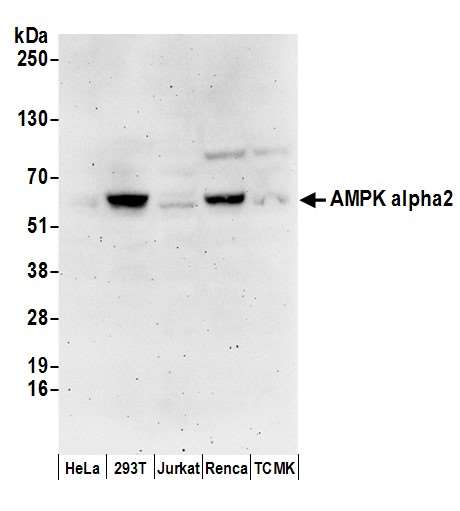Anti-AMPK alpha 2 (13010)
Anti-AMPK alpha 2 (13010)
Product No.: 13010
- -
- -
Target AMPKα 2 Product Type Polyclonal Alternate Names AMPK subunitα-2, EC 2.7.11.1, Acetyl-CoA carboxylase kinase, ACACA kinase, EC 2.7.11.27, Hydroxymethylglutaryl-CoA reductase kinase, HMGCR kinase, EC 2.7.11.31 Isotype Whole IgG Applications IP , WB |
Data
 Detection of human and mouse AMPK alpha 2 by western blot. Samples: Whole cell lysate (50 µg) from HeLa, HEK293T, Jurkat, mouse Renca, and mouse TCMK-1 cells. Antibodies: Affinity purified rabbit anti-AMPK alpha 2 antibody 13010 (lot 13010-2) used for WB at 0.4 µg/ml. Detection: Chemiluminescence with an exposure time of 3 minutes.
Detection of human and mouse AMPK alpha 2 by western blot. Samples: Whole cell lysate (50 µg) from HeLa, HEK293T, Jurkat, mouse Renca, and mouse TCMK-1 cells. Antibodies: Affinity purified rabbit anti-AMPK alpha 2 antibody 13010 (lot 13010-2) used for WB at 0.4 µg/ml. Detection: Chemiluminescence with an exposure time of 3 minutes. - -
- -
Antibody DetailsProduct DetailsReactivity Species Bovine ⋅ Human ⋅ Rat Host Species Rabbit Immunogen Synthetic peptide representing a portion of the protein encoded within exon 7. Product Concentration Lot Specific Formulation Tris-citrate/phosphate buffer, pH 7 to 8 containing 0.09% Sodium Azide State of Matter Liquid Product Preparation Purified by immunoaffinity chromatography Storage and Handling This antibody is stable at 2-8°C for 1 year. Country of Origin USA Shipping Next Day 2-8°C Applications and Recommended Usage? Quality Tested by Leinco Immunoblotting: use at 0.2-2ug/mLDetection of human and mouse AMPK alpha 2 in whole cell lysates (50 ug) of HeLa, 293T, Jurkat, mouse Renca, and mouse TCMK-1 cells with #13010 at 0.4ug/mL. Each investigator should determine their own optimal working dilution for specific applications. See directions on lot specific datasheets, as information may periodically change. DescriptionSpecificity This affinity-purified antibody reacts with human, mouse, rat and bovine AMPK alpha-2. The epitope recognized is in the region between aa 350 and 400 of AMPK alpha-2. Based on 100% sequence identity, this antibody is predicted to react with Mouse, Rabbit, Guinea pig, Pig, Orangutan, Rhesus Monkey, Gorilla, Chimpanzee, Whitetufted-ear marmoset, Crab-eating macaque, African elephant, Chinese hamster, Naked mole rat and Northern white-cheeked gibbon. Background MP-activated protein kinase (AMPK) is a key enzyme in cellular energy management. This heterotrimeric protein consists of a catalytic alpha subunit and regulatory beta and gamma subunits. Notably, there are two distinct genes for the alpha subunit: alpha1 and alpha2. In this context, AMPK alpha2 functions as the serine/threonine kinase catalytic subunit. AMPK plays a crucial role in regulating fatty acid and cholesterol synthesis. It becomes activated in response to various metabolic stresses, effectively shutting down anabolic (energy-consuming) pathways when cellular ATP levels are depleted. This action helps maintain cellular energy balance. Antigen DetailsFunction Catalytic subunit of AMP-activated protein kinase (AMPK), an energy sensor protein kinase that plays a key role in regulating cellular energy metabolism (PubMed:17307971, PubMed:17712357). In response to reduction of intracellular ATP levels, AMPK activates energy-producing pathways and inhibits energy-consuming processes: inhibits protein, carbohydrate and lipid biosynthesis, as well as cell growth and proliferation (PubMed:17307971, PubMed:17712357). AMPK acts via direct phosphorylation of metabolic enzymes, and by longer-term effects via phosphorylation of transcription regulators (PubMed:17307971, PubMed:17712357). Regulates lipid synthesis by phosphorylating and inactivating lipid metabolic enzymes such as ACACA, ACACB, GYS1, HMGCR and LIPE; regulates fatty acid and cholesterol synthesis by phosphorylating acetyl-CoA carboxylase (ACACA and ACACB) and hormone-sensitive lipase (LIPE) enzymes, respectively (PubMed:7959015). Promotes lipolysis of lipid droplets by mediating phosphorylation of isoform 1 of CHKA (CHKalpha2) (PubMed:34077757). Regulates insulin-signaling and glycolysis by phosphorylating IRS1, PFKFB2 and PFKFB3 (By similarity). Involved in insulin receptor/INSR internalization (PubMed:25687571). AMPK stimulates glucose uptake in muscle by increasing the translocation of the glucose transporter SLC2A4/GLUT4 to the plasma membrane, possibly by mediating phosphorylation of TBC1D4/AS160 (By similarity). Regulates transcription and chromatin structure by phosphorylating transcription regulators involved in energy metabolism such as CRTC2/TORC2, FOXO3, histone H2B, HDAC5, MEF2C, MLXIPL/ChREBP, EP300, HNF4A, p53/TP53, SREBF1, SREBF2 and PPARGC1A (PubMed:11554766, PubMed:11518699, PubMed:15866171, PubMed:17711846, PubMed:18184930). Acts as a key regulator of glucose homeostasis in liver by phosphorylating CRTC2/TORC2, leading to CRTC2/TORC2 sequestration in the cytoplasm (By similarity). In response to stress, phosphorylates 'Ser-36' of histone H2B (H2BS36ph), leading to promote transcription (By similarity). Acts as a key regulator of cell growth and proliferation by phosphorylating TSC2, RPTOR and ATG1/ULK1: in response to nutrient limitation, negatively regulates the mTORC1 complex by phosphorylating RPTOR component of the mTORC1 complex and by phosphorylating and activating TSC2 (PubMed:14651849, PubMed:20160076, PubMed:21205641). In response to nutrient limitation, promotes autophagy by phosphorylating and activating ATG1/ULK1 (PubMed:21205641). In that process also activates WDR45/WIPI4 (PubMed:28561066). Phosphorylates CASP6, thereby preventing its autoprocessing and subsequent activation (PubMed:32029622). AMPK also acts as a regulator of circadian rhythm by mediating phosphorylation of CRY1, leading to destabilize it (By similarity). May regulate the Wnt signaling pathway by phosphorylating CTNNB1, leading to stabilize it (By similarity). Also acts as a regulator of cellular polarity by remodeling the actin cytoskeleton; probably by indirectly activating myosin (PubMed:17486097). Also phosphorylates CFTR, EEF2K, KLC1, NOS3 and SLC12A1 (PubMed:12519745, PubMed:20074060). Plays an important role in the differential regulation of pro-autophagy (composed of PIK3C3, BECN1, PIK3R4 and UVRAG or ATG14) and non-autophagy (composed of PIK3C3, BECN1 and PIK3R4) complexes, in response to glucose starvation (By similarity). Can inhibit the non-autophagy complex by phosphorylating PIK3C3 and can activate the pro-autophagy complex by phosphorylating BECN1 (By similarity). {UniProtKB:Q09137, UniProtKB:Q8BRK8, PubMed:11518699, PubMed:11554766, PubMed:12519745, PubMed:14651849, PubMed:15866171, PubMed:17486097, PubMed:17711846, PubMed:18184930, PubMed:20074060, PubMed:20160076, PubMed:21205641, PubMed:25687571, PubMed:28561066, PubMed:32029622, PubMed:34077757, PubMed:7959015, PubMed:17307971, PubMed:17712357}. NCBI Gene Bank ID UniProt.org Research Area Enzymes References & CitationsTechnical Protocols |


